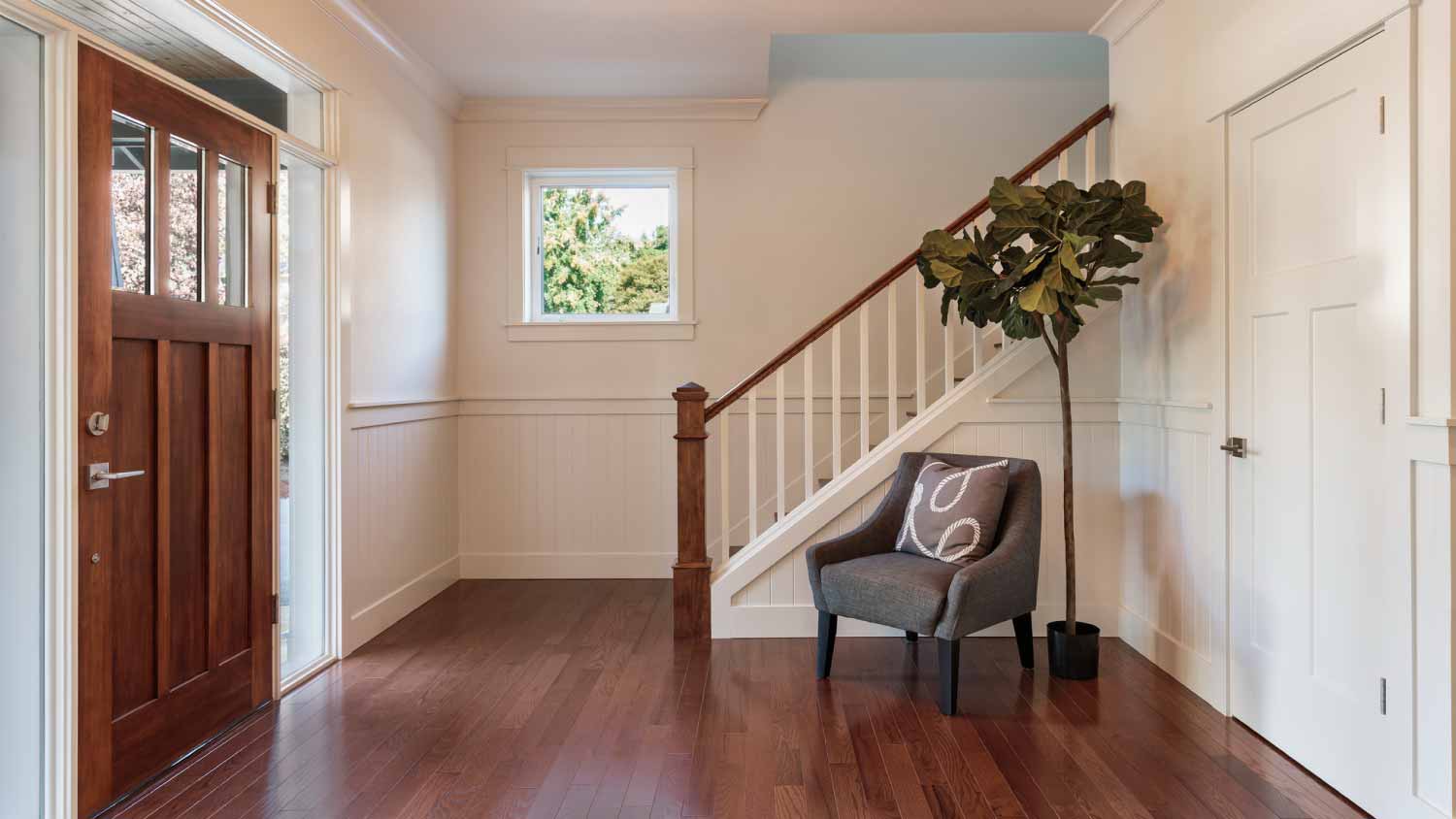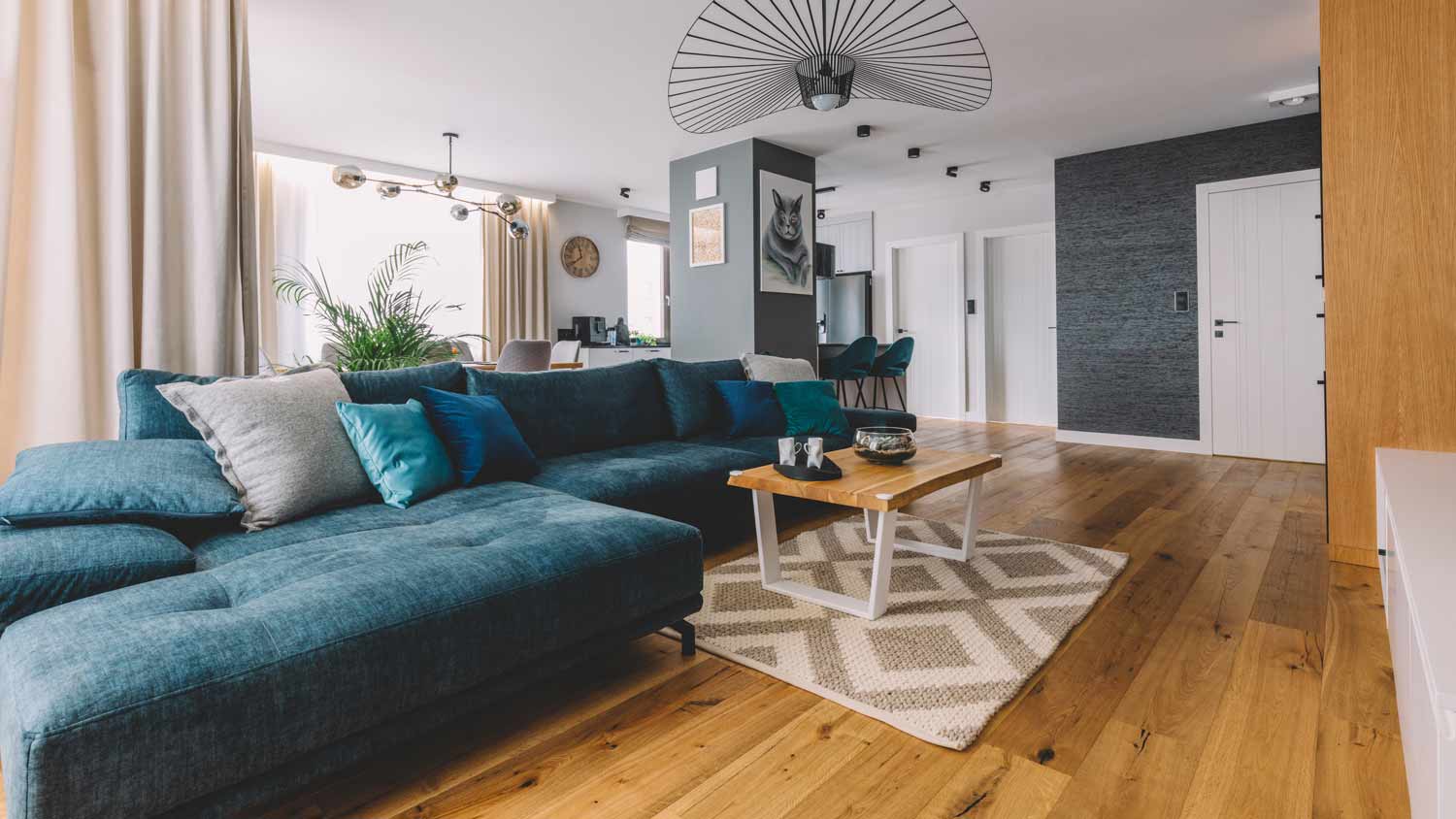6 Easy Steps to Install Cork Flooring
Make a design splash with a floating floor


- Pry bar
- Grinder
- Cup grinder wheel
- Putty knife
- 5-in-1 painter’s tool
- Leather gloves
- Rubber gloves
- Dust mask
- Rags
- Cork flooring
Compactly pressed with a myriad of color variations and style options, cork floor tiles give a soft, cushy feel beneath your feet. While the cost of new flooring might be a shock to your wallet if you’re looking at other high-end materials like hardwood or stone, cork flooring can be an affordable solution that still maintains a high-end, design-forward look. If you’re considering this as a DIY project for your home, here’s how to install cork flooring step by step.
Buying Cork Flooring
Cork flooring averages about $5 per square foot, and is typically sold in a plank or tile form. For this project, you’ll want to plan for flooring adhesive, cork materials, and a sealant like polyurethane.
Prepping to Install Cork Flooring
Before you begin installation, you’ll need a pristine work surface, which means ripping up the previous flooring and using a vacuum to suck up dust and friable debris from every nook and cranny.
If you’re removing a laminate floor secured in place with glue or tile affixed by concrete, use a vinyl scraper to remove the old glue or a hammer chisel to break up the mortar and create a level surface for your new cork floor. If the underlying material is so old that it isn’t coming up, grind it down using a cup wheel attachment on a hand grinder.
If the room in which you’re installing cork flooring has baseboards or casing trim, remove them before you start so that you can install the cork planks flush against the walls. Since cork is a flexible product that expands with the temperature, you’ll need to take it out of its packaging at least a week before installation and let it air out to fully acclimate to the room’s humidity.
6 Steps to Install Cork Flooring

Lay Out the Planks
Before cutting the cork, lay out and measure the pieces to see where each lines up with the room’s perimeter entrances. Doing this will help you estimate where you’ll need to make cuts and save you the trouble of having to create little slivers of flooring to fill in important areas.
Once you have the pieces of cork gridded out, step back and move them around in the most aesthetically pleasing pattern, which could mean that you rotate all of the tiles 45 degrees in a diamond layout instead of a standard configuration. Pay particular attention to entryways and transition points—like between carpet or other kinds of flooring—and start there, working your way toward the corners. These areas will likely have furniture on top once you’re done or, at the very least, be hidden along the outer edges of the room.
Spread the Glue
Working in sections, spread the adhesive onto the subfloor with a notched trowel. The notches in the trowel create breathing room for the glue to fill once you press the cork tile down into the subfloor and form a solid connection between the two—so don’t skip this important step and just pour the glue out! Wear rubber gloves and have disposable rags on hand to keep things tidy with this sticky substance, which can easily get out of hand.
Pro tip: Have a piece of plywood at the ready to lay on top of your newly glued flooring so that you can continue working without shifting the cork tiles.
Trim the Planks
Put on your leather gloves to protect your fingers during this step. Using a carpenter's level or straight edge, cut the cork planks with a razor blade so that they fit tight against the edges of the room as you lay them. Work methodically, laying down the glue for just the pieces you're installing, one by one.
Lay Down the Cork
As you move along each section of the room, firmly press the entire cork tile down into the glue bed and line up the edges. There will likely be stray adhesive here and there, so have a damp rag handy to clean up the overflow before it dries. Move your small piece of plywood along with you, putting it down to kneel on as you’re working on top of the newly glued tiles.
Give the Floor a Final Protective Coat
After you’ve installed your cork flooring, consider adding a final protective finish of polyurethane (or what the manufacturer recommends as a top coat). While this step is not required, it’s an added precaution to protect your investment and preserve the cork floor as long as possible. This will create an impenetrable barrier that can be polished, waxed, and walked on for years to come.
Remount the Trim and Baseboards
Once your floor is ready to go, the final touches are putting back up the casing trim, baseboards, and any other pieces like toe kicks you may have removed at the beginning of the process—or replacing them entirely if they’re due for an upgrade.
DIY Cork Flooring vs. Hiring a Pro
Learning how to install cork flooring is easier than working with other floor materials like hardwood, thanks to the product’s flexibility during the cutting process and the interlocking system that allows the adjoining pieces to click into place. If you’re handy with tools, this is a flooring project you can DIY. If you'd rather not DIY with heavy power tools, you'll want to hire a flooring company or handyman to complete this job for you, particularly during the preparation phase.
Additional Questions About Cork Flooring
How expensive is it to install cork flooring?
According to HomeAdvisor, cork flooring ranges from $5 to $14 per square foot. You can purchase the material in either cork planks or tiles. If you’re hiring a professional to install the cork floor, add another $2 per square foot to the overall price to account for preparation and overhead.
Why should I use cork underlay for cork floating floors?
While the cork tile will provide a good base for your flooring by itself, the addition of a subfloor that is also cork will level up the installation. Creating an extremely flat surface for cork flooring is important to cover imperfections and help with the final installation process. Cork underlayment is also a very affordable option in place of plywood sheets.

.jpg?impolicy=leadImage)


















